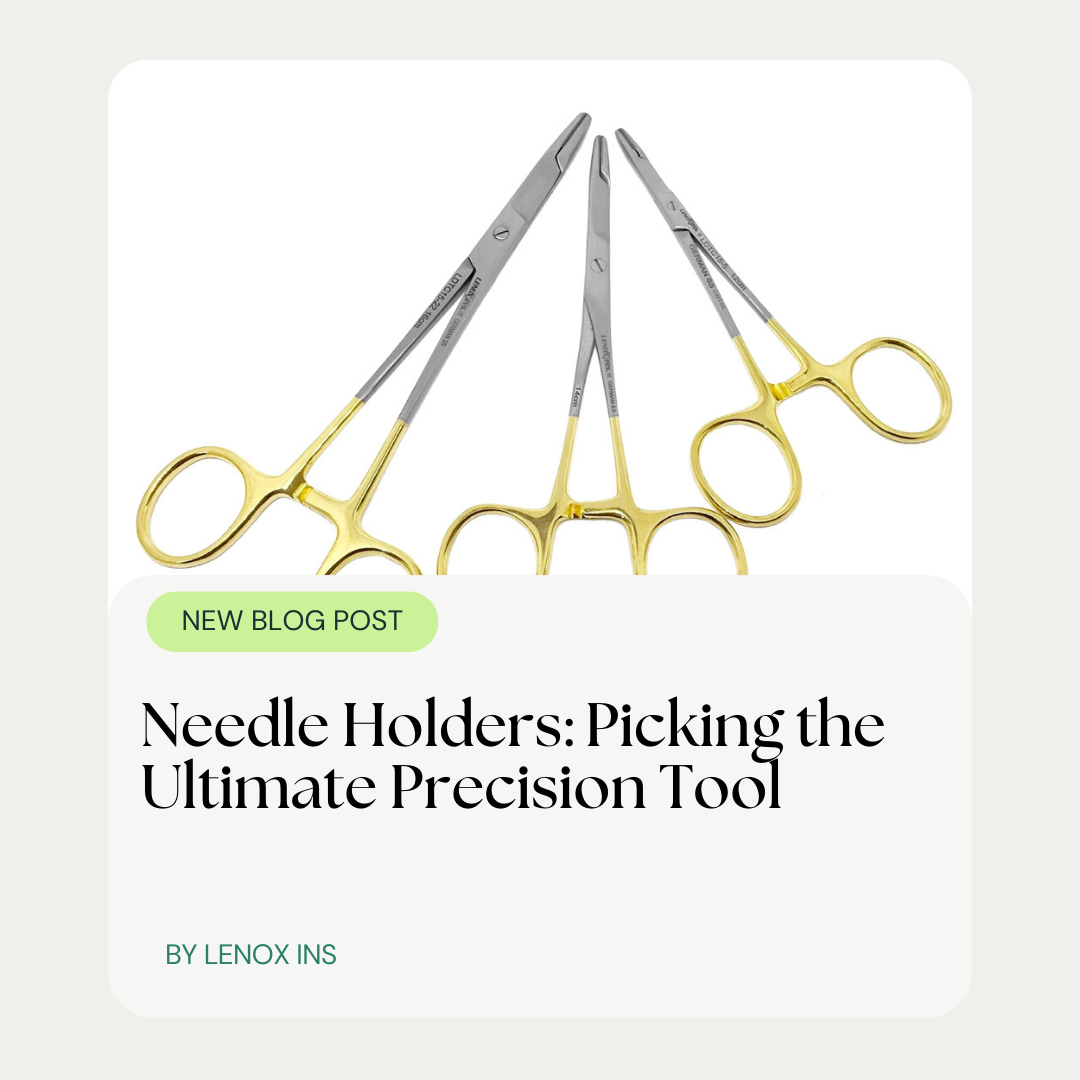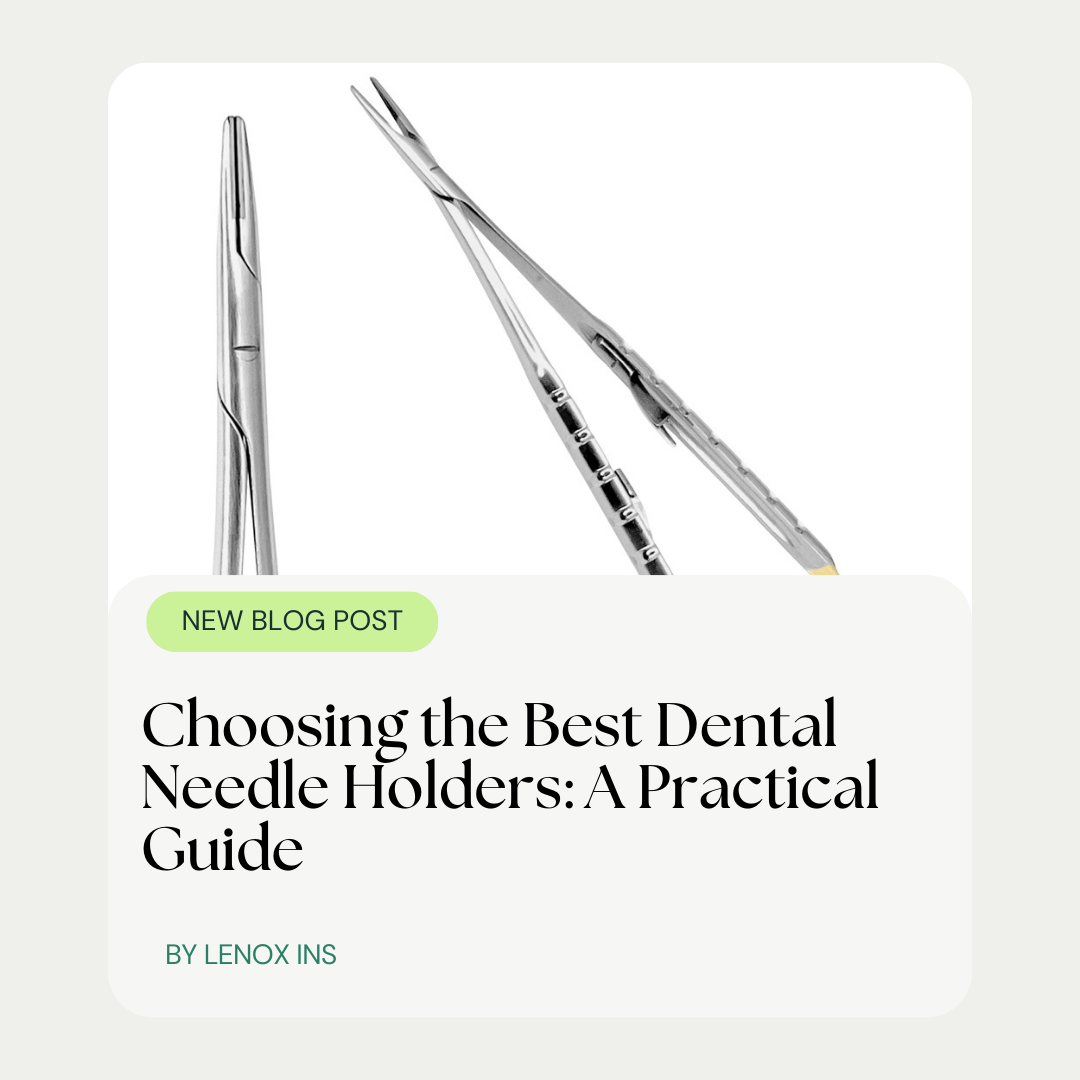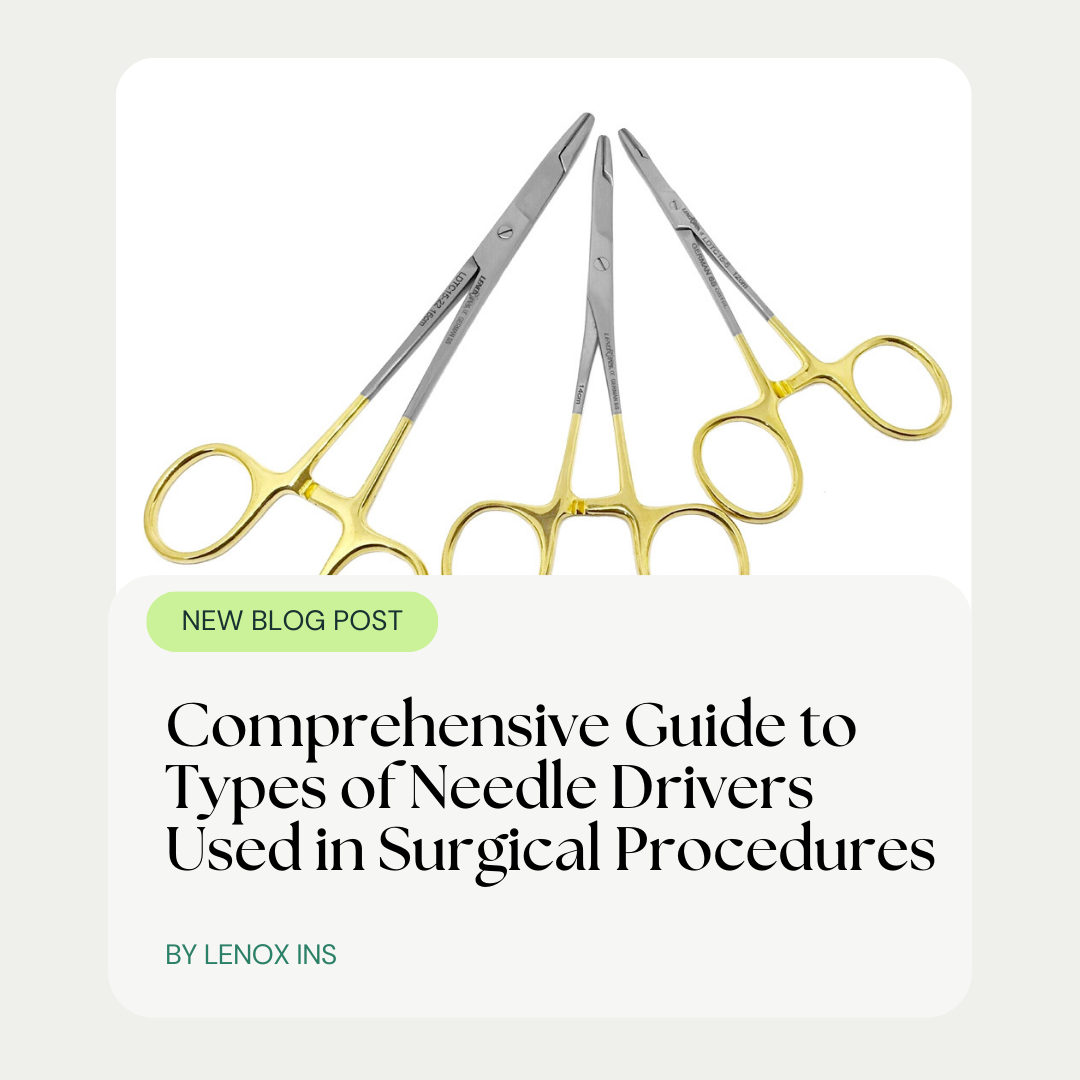Needle Holders: Picking the Ultimate Precision Tool
- Posted November 5, 2024
- by lenoxinstro
Selecting the right ergonomic needle driver is essential for precision in surgery, particularly in laparoscopic procedures. Many surgeons struggle with discomfort and pain in their hands and muscles during extended use of traditional instruments. This blog post will discuss the key features to consider when choosing an ergonomic needle driver, explore the different types available, and outline the steps to find the ideal fit. By understanding these elements, readers can enhance their surgical efficiency and reduce the risk of strain, ultimately improving patient outcomes.
Key Takeaways
- Ergonomic needle drivers enhance precision and reduce hand fatigue during surgical procedures
- The ratchet mechanism in needle drivers ensures consistent pressure for better control
- Material selection, particularly tungsten carbide, improves durability and sterilization in surgical instruments
- Specialty needle drivers cater to the unique demands of specific surgical fields for better outcomes
- Future trends include smart technologies and personalized tools to improve comfort and performance
Understanding the Importance of Ergonomic Needle Drivers in Surgery

Needle drivers are essential surgical instruments that significantly impact the outcomes of various procedures by assisting in suturing with precision. However, traditional needle drivers often present challenges, such as discomfort and reduced control, especially during lengthy operations. Ergonomically designed needle drivers address these issues, enhancing a surgeon‘s precision and safety while reducing strain on the finger and hand, ultimately benefiting the patient.
The Critical Role of Needle Drivers in Surgical Procedures
Needle drivers play a vital role in surgical procedures, allowing a surgeon to grasp and manipulate sutures with precision. Effective needle drivers incorporate features such as a ratchet mechanism, which enables surgeons to apply consistent pressure while maintaining control over delicate knots. Ergonomically designed needle drivers can alleviate strain on the thenar eminence, enhancing comfort and reducing fatigue during lengthy operations, which is crucial in fields like veterinary medicine where precise suturing can significantly impact patient outcomes.
- Importance of precision in surgical procedures
- Role of the ratchet mechanism for consistent pressure
- Impact of ergonomic design on surgeon comfort
- Significance in veterinary medicine for patient outcomes
Challenges Posed by Traditional Needle Drivers
Traditional needle drivers often introduce several challenges that can hinder surgical performance. One significant issue is the uncomfortable grip angle, which can strain the wrist and thumb over prolonged use, leading to fatigue and reduced dexterity. Additionally, the jaw design of many conventional needle drivers does not effectively accommodate varying suture sizes or types, making precision difficult and potentially affecting patient outcomes, especially in delicate procedures.
- Uncomfortable grip angles causing wrist strain
- Fatigue from prolonged use affecting surgeon performance
- Poor jaw design impacting precision with sutures
- Potential negative outcomes during delicate procedures
How Ergonomics Enhances Surgeon Precision and Safety
Ergonomically designed needle drivers play a crucial role in enhancing surgeon precision and safety throughout surgical procedures. These tools are often constructed from durable materials, such as tungsten, which resist corrosion and ensure longevity in the operating room. The ergonomic features, including specially designed grips and optimized angles, significantly reduce strain on the surgeon‘s hands and wrists, ensuring better control when manipulating sutures and other instruments like forceps and tweezers, particularly in delicate fields like plastic surgery:
- Durable materials like tungsten enhance tool longevity.
- Ergonomic grips reduce hand and wrist strain.
- Improved control increases precision in delicate suturing.
- Essential for optimal performance in complex procedures.
A good needle driver can make the difference in a surgeon’s hands. Next, it is time to look at the key features that define an ergonomic needle driver.
Key Features to Consider When Choosing an Ergonomic Needle Driver

Choosing the right ergonomic needle driver is crucial for achieving surgical precision. Key features to consider include handle design and comfort for prolonged use, which ensure a secure grip during lengthy procedures. Optimal weight distribution and balance enhance maneuverability. Material selection, particularly tungsten carbide, guarantees durability and ease of sterilization. Finally, mechanism functionality and responsiveness impact overall control, making these elements vital for any needle holder used in general surgery.
Handle Design and Comfort for Prolonged Use
Handle design and comfort are critical factors when selecting an ergonomic needle driver, particularly for extended surgical procedures. A well-designed handle allows for a secure grip and minimizes hand fatigue, enabling surgeons to maintain precision and control over time. The ergonomic features should cater to the natural positioning of the hand, which enhances comfort and allows for better maneuverability during intricate suturing tasks:
- Secure grip reduces hand fatigue during long surgeries.
- Ergonomic features support natural hand positioning.
- Improved maneuverability enhances precision in suturing tasks.
Optimal Weight Distribution and Balance
Optimal weight distribution and balance are crucial when selecting an ergonomic needle driver, as they directly influence a surgeon‘s ability to perform intricate suturing tasks with precision. A well-balanced tool enables better control and reduces the risk of hand fatigue, which can compromise performance during lengthy procedures. Surgeons often benefit from needle drivers that maintain an even weight throughout the instrument, allowing for fluid movements and the ability to focus on delicate suturing without unnecessary strain on their hands and wrists.
Material Selection for Durability and Sterilization
Material selection is a critical factor when choosing an ergonomic needle driver, as it directly impacts both durability and sterilization. Recommended materials, such as tungsten carbide, offer superior strength and corrosion resistance, ensuring the tool’s longevity in a demanding surgical environment. Furthermore, the ease of sterilization of these materials is essential for maintaining hygiene standards, which is vital for patient safety and optimal surgical outcomes.
Mechanism Functionality and Responsiveness
Mechanism functionality and responsiveness are critical attributes of an ergonomic needle driver that directly impact surgical precision. A needle driver with a reliable mechanism allows surgeons to smoothly engage and release sutures, ensuring consistent tension and control during intricate procedures. Moreover, the responsiveness of the mechanism can significantly reduce the time taken to manipulate sutures, which is essential in maintaining focus and efficiency during operations.
- Reliable mechanism for smooth engagement and release of sutures
- Consistent tension enhances control during intricate procedures
- Improved responsiveness reduces manipulation time
With the essential features in mind, the search for the right tool narrows. Next, different types of ergonomic needle drivers await exploration, each offering unique benefits for precise sewing tasks.
Exploring Different Types of Ergonomic Needle Drivers

Various types of ergonomic needle drivers are available, each designed to enhance surgical precision. Spring-loaded needle drivers provide quick suture engagement, while rotating models allow for easier maneuverability around complex anatomical structures. Adjustable and modular options cater to diverse surgical needs, and specialty needle drivers are tailored for specific fields, further advancing surgical outcomes.
Overview of Spring-Loaded Needle Drivers
Spring-loaded needle drivers are designed for efficient suture engagement, allowing surgeons to quickly grasp and manipulate sutures with minimal effort. The spring mechanism provides a reliable and consistent grip, which is particularly beneficial during intricate procedures where precision is paramount. These needle drivers enhance maneuverability and reduce hand fatigue, making them an ideal choice for lengthy surgical operations:
| Feature | Benefit |
|---|---|
| Spring Mechanism | Ensures quick and reliable suture grasping |
| Effortless Operation | Minimizes hand fatigue during extended use |
| Precision Control | Enhances maneuverability in complex surgical tasks |
Benefits of Rotating Needle Drivers
Rotating needle drivers offer significant advantages in surgical precision, especially in complex operations where maneuverability is crucial. Their ability to pivot allows surgeons to easily navigate around intricate anatomical structures, which enhances access and control during suturing tasks. This design not only improves efficiency but also reduces strain on the hands, ultimately supporting better surgical outcomes and patient safety.
Adjustable and Modular Needle Driver Options
Adjustable and modular needle drivers provide surgeons with the flexibility to adapt their tools to specific surgical requirements, enhancing overall performance. These instruments often feature interchangeable components that allow for customization based on different suture types or surgical techniques. By offering the ability to adjust the grip, jaw size, or tension mechanism, these needle drivers enable surgeons to maintain optimal precision and control during complex procedures, ultimately contributing to improved surgical outcomes and patient safety.
Specialty Needle Drivers for Specific Surgical Fields
Specialty needle drivers are designed to meet the unique demands of specific surgical fields, enhancing precision and efficiency in procedures. For instance, ophthalmic needle drivers are tailored for delicate eye surgeries, featuring finer jaws to accommodate smaller sutures, while gynecological needle drivers often have an angled design for better access in confined spaces. By selecting a specialty needle driver that aligns with the requirements of a particular surgical discipline, surgeons can optimize their performance and improve patient outcomes.
Choosing the right ergonomic needle driver matters. Understanding how to select the best one can lead to greater comfort and efficiency in your work.
Steps to Selecting the Ideal Ergonomic Needle Driver

Identifying the ideal ergonomic needle driver involves several important considerations. Assessing personal surgical needs and preferences ensures that the selected tool aligns with the surgeon‘s technique. Evaluating compatibility with various surgical techniques enhances effectiveness, while considering hand size and grip style promotes comfort during use. Lastly, reviewing manufacturer reliability and support services secures a quality instrument for optimal performance.
Assessing Personal Surgical Needs and Preferences
Assessing personal surgical needs and preferences is a crucial step in selecting the ideal ergonomic needle driver for surgical precision. Surgeons should consider their specific surgical techniques and the types of suturing tasks they frequently perform to identify which features would enhance their performance. For instance, a surgeon specializing in microsurgery may require a needle driver with a finer grip and precision control, while a general surgeon might prioritize versatility and comfort for longer procedures:
| Consideration | Importance |
|---|---|
| Surgical Technique | Identifies necessary precision and control features |
| Task Requirements | Determines ideal jaw design and grip style |
| Comfort Preferences | Reduces fatigue during prolonged operations |
Evaluating Compatibility With Surgical Techniques
Evaluating compatibility with surgical techniques is essential when selecting an ergonomic needle driver, as different procedures may demand specific features. For instance, a needle driver designed for microsurgery needs finer tips and increased precision to handle delicate suturing, while those used in general surgery may prioritize versatility and user comfort for longer operations. Understanding the nuances of each surgical technique allows surgeons to choose a needle driver that enhances their performance and meets the unique demands of their specialties.
Considering Hand Size and Grip Style
When selecting an ergonomic needle driver, considering hand size and grip style is essential for maximizing comfort and performance. A well-fitted handle ensures that surgeons maintain a secure grip during prolonged use, which is critical when precision is required. Surgeons with larger hands may benefit from a wider grip, while those with smaller hands might prefer a narrower design to enhance control and reduce hand fatigue:
- Assess hand size to match needle driver handle dimensions.
- Choose grip styles that cater to individual comfort levels.
- Test different options to identify the best fit for precision tasks.
Reviewing Manufacturer Reliability and Support Services
When selecting an ergonomic needle driver, reviewing manufacturer reliability and support services is essential. A reputable manufacturer will ensure the quality and durability of the needle driver, which is critical for maintaining surgical precision. Additionally, companies that provide thorough support services, such as warranties and user assistance, can help address any issues or concerns that may arise post-purchase, further enhancing the surgical experience:
| Criteria | Importance |
|---|---|
| Manufacturer Reputation | Ensures quality and reliability of instruments |
| Warranty Options | Provides assurance and support for repairs |
| Customer Support Services | Offers assistance during product use and troubleshooting |
Selecting the right ergonomic needle driver sets the stage for improved performance. In the following section, the benefits of these tools become clear and compelling.
Advantages of Using Ergonomic Needle Drivers

Ergonomic needle drivers significantly reduce hand fatigue and the risk of musculoskeletal disorders associated with extended surgical procedures. Their design enhances surgical accuracy and efficiency, leading to improved patient outcomes through precise suturing. Additionally, these tools provide long-term benefits for surgical practice by promoting better ergonomics and comfort for surgeons, ultimately elevating the overall quality of care.
Reducing Hand Fatigue and Risk of Musculoskeletal Disorders
Ergonomic needle drivers significantly contribute to reducing hand fatigue and the risk of musculoskeletal disorders associated with prolonged surgical procedures. Designed with comfort in mind, these instruments allow surgeons to maintain a natural grip and positioning, minimizing strain on the hand and wrist. By promoting better ergonomic principles in the operating room, surgeons can perform with greater efficiency and less discomfort, ultimately enhancing their long-term well-being and patient care quality.
Enhancing Surgical Accuracy and Efficiency
Ergonomic needle drivers significantly enhance surgical accuracy and efficiency by allowing surgeons to maintain optimal control and precision during delicate procedures. Their design, which promotes a natural grip and minimizes hand strain, enables quicker and more accurate movements when suturing, reducing the likelihood of errors that could impact patient outcomes. Surgeons who use these specialized tools can perform intricate tasks with greater focus and less fatigue, ultimately contributing to streamlined operations and improved overall performance in the operating room.
Improving Patient Outcomes Through Precision
Utilizing ergonomic needle drivers enhances surgical precision, leading to improved patient outcomes. These tools enable surgeons to execute delicate suturing techniques with greater control, reducing the risk of complications during procedures. For instance, a surgeon using an ergonomic design can maintain steady hands, minimizing tissue trauma and promoting quicker healing times, ultimately benefiting patient recovery and satisfaction.
Long-Term Benefits for Surgical Practice
Utilizing ergonomic needle drivers not only enhances immediate surgical outcomes but also fosters long-term benefits for surgical practice. By reducing hand fatigue and the risk of musculoskeletal disorders, these instruments contribute to sustained surgeon performance and well-being. This leads to fewer injuries, less time off work, and overall improved job satisfaction, which directly translates to enhanced patient care quality over time:
- Reduced risk of injuries and fatigue for surgeons
- Improved job satisfaction and performance longevity
- Enhanced patient care through consistent high-quality outcomes
Ergonomic needle drivers offer clear benefits, but real value shines through lived experiences. The stories of those who use them reveal deeper insights worth exploring.
Real-World Insights and Testimonials

Case studies showcasing improved surgical performance highlight the positive impact of ergonomic needle drivers in various settings. Surgeons share their experiences with these tools, emphasizing the reduction in hand strain and enhanced precision. Additionally, an exploration of how to effectively integrate ergonomic instruments into daily practice provides valuable insights. Lastly, examining future trends in surgical instrument ergonomics offers a glimpse into ongoing advancements that aim to further optimize surgical outcomes.
Case Studies Demonstrating Improved Surgical Performance
Multiple case studies have illustrated the tangible benefits of ergonomic needle drivers in enhancing surgical performance. A recent study involving general surgeons highlighted a significant reduction in hand fatigue and improved suturing precision when switched from traditional to ergonomic designs, leading to more efficient surgeries and shorter recovery times for patients. Similarly, a group of plastic surgeons reported enhanced dexterity and control during intricate procedures, affirming that the adoption of ergonomic needle drivers not only improved surgical outcomes but also increased overall job satisfaction among the surgical team.
Surgeon Experiences With Ergonomic Needle Drivers
Surgeons who’ve transitioned to ergonomic needle drivers often report significant improvements in their surgical performance. Many emphasize that these tools provide a more comfortable grip, enabling them to maintain precision during extended procedures. Additionally, firsthand accounts highlight that reduced hand strain translates into increased focus on the task, resulting in higher-quality suturing and enhanced patient outcomes.
Integrating Ergonomic Tools Into Daily Practice
Integrating ergonomic tools into daily surgical practice involves training and familiarizing the surgical team with the unique features that enhance precision and comfort. Practical workshops can demonstrate the benefits of ergonomic needle drivers, showcasing how they reduce hand fatigue and improve suturing accuracy during complex procedures. As surgeons adopt these specialized instruments, they often find that the enhanced control leads to more efficient surgeries and better patient outcomes, ultimately transforming their approach to surgical tasks.
Future Trends in Surgical Instrument Ergonomics
Future trends in surgical instrument ergonomics focus on incorporating advanced materials and technologies to enhance comfort, safety, and performance in surgical practices. Innovations such as smart needle drivers equipped with sensors provide real-time feedback on grip pressure and suture tension, aiding surgeons in achieving optimal control during delicate procedures. Moreover, ongoing research emphasizes personalized tools tailored to individual surgeon preferences and anatomical needs, ultimately improving precision and reducing fatigue.
| Trend | Description |
|---|---|
| Smart Technologies | Needle drivers with sensors for real-time feedback on grip and suture tension. |
| Advanced Materials | Use of lightweight and durable materials to enhance comfort and usability. |
| Personalized Tools | Customization options based on individual surgeon preferences and anatomical needs. |
Conclusion
Selecting the ideal ergonomic needle driver is crucial for achieving surgical precision and enhancing overall performance in the operating room. Key features such as handle design, weight distribution, and material selection significantly impact comfort and control during procedures. By prioritizing personal surgical needs and ensuring compatibility with various techniques, surgeons can optimize their instruments for improved patient outcomes. Investing in ergonomic needle drivers not only promotes surgeon well-being but also elevates the quality of care delivered to patients.









